
 |
|||||
|
|
|||||
|
|
|
|||||
|
|
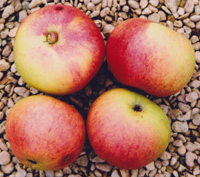 |
LONGSTOCK BLUSH In the village of Longstock, alongside the River Test, near Stockbridge in Hampshire, is a farmhouse that goes back to the 1500s. Within a few feet of the wall is a single old apple tree. The owners, Mark and Rosie Flewitt (Rosie being Judy’s sister) have enjoyed the apples for many years now and we established a tree of it here, just as many years ago. The medium sized cooking apples are rounded, with yellow skin carrying a rose and crimson blush in the sun. The apples are ripe in early to mid November and are a little too sharp to enjoy raw. Cooked, they soften fairly quickly, going floppy and willing to be mashed to a fluffy purée. The flavour is very rich and sweet, with a good tang and lively acid. The cooked flesh goes pink if left to stand. Pollination Group 6 |
||
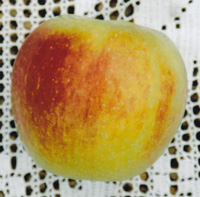 |
LONGWORTH BRYONY Given to us by Kristin Felton, of Bryony Cottage, Longworth, Oxfordshire. An old tree in her garden had to go to accommodate an extension and she was concerned that the unknown variety should not die out. The apples are regular, quite large and golden with a red flush and streaks, when ripe at the start of September. The tree was a prolific bearer, though modest in size and was mature decades ago, when Chris first came to the property. She thought it a culinary apple that becomes an eater when fully ripe, but we found it a most enjoyable dessert apple which can also be cooked. It is sweet and fragrant, richly flavoured and with an agreeable acidity. When cooked it kept its shape completely and had a well balanced flavour. It keeps for a month or two. Pollination Group 3 |
|||
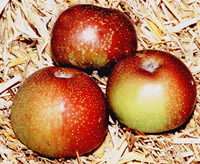 |
LORD
BURGHLEY The origin is subject to conflicting detail, but it
seems to have been found as a seedling and rescued from wasteland by the
Head Gardener, Mr Matheson, at the Marquis of Exeter's gardens at Burghley
Park, near Stamford. This was in 1834. It was introduced by Mr House of
Peterborough. Scott (1872) said it was raised by Mr House. Others say
it was introduced in 1865 by Mattheson and distributed by House. Scott
described it as being “very tender, juicy and sweet with a fine
pineapple flavour and rich aroma. This delicious fruit has a tenderness
of flesh and flavour even superior to Cox’s Orange Pippin. The two
should be extensively cultivated by all lovers or first-class fruits”.
Bunyard (1920) considered it one of the best eating apples. Attractive
apples with a deep red to mahogany skin which are ripe in October, and
will last well into April. Pollination Group 5 |
|||
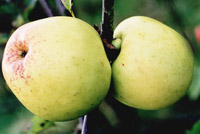 |
LORD
DERBY According to the Herefordshire Pomona (1876-85), this is
one of the finest culinary apples, ripe before the common Bramley. It
was raised by Mr Witham, a nurseryman of Stockport, and recorded in 1862.
It has a similar shape to the distinctive 'angular' Catshead, turns from
green to yellow when ripe and has a rich, sharp flavour. It quickly cooks
to a purée, mild and pleasant, without the need for much if any
sugar. Some references say it keeps its shape, but we have not found this.
The trees are very hardy and grow well in the north and on wet soil. It
has therefore been a favourite in the north and Scotland. A good, reliably
cropping tree. Pollination Group 5 |
|||
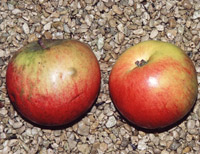 |
LORD
HINDLIP Introduced in 1896, having arisen on Lord Hindlip's estate
in Worcestershire. An attractive fruit, streaked with deep crimson, and
with firm, sweet and juicy flesh. The flavour is aromatic, tangy and refreshing.
Ripe in mid October and storing until February. A reliable cropper. Pollination
Group 3 |
|||
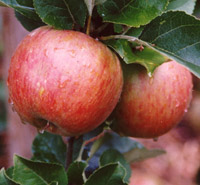 |
LORD
LAMBOURNE Another famous dessert apple raised by the Laxton Brothers
of Bedford, in 1907. It is a cross between James Grieve and Worcester
Pearmain. Introduced in 1921, it was named after a past president of the
R.H.S.. Sweet, juicy fruit, with rich aromatic flesh. Popular in gardens
as the trees are compact and only moderately vigorous, with good crops.
Partially tip-bearing. Ready to pick in September; stores until November.
It has been said to dislike wet climates, but we hear from good friends,
John and Josephine Riley, formerly of Bowen Island, British Columbia,
Canada, that it excels in their cold, damp climate and succeeds where
most other apples fail from poor pollination. Dusky blossom. Pollination
Group 3 |
|||
LORD
WOLSELEY This apple, though made a synonym of Dewdney’s
Seedling and Devonshire Buckland by others, is a distinct apple. It appears
to have disappeared in the UK but is now back. Taylor, in ‘The Apples
of England’ in 1946 says that Lord Wolseley was planted in the National
Fruit Trials in 1923 and that it was a culinary apple, large, round, flattish
with smooth, clear yellow skin, and a faint brownish red flush. The eye
was said to be closed and the stalk short in a russety cavity. The fruit
was ripe in September. It appears very close in description to the Lord
Wolseley reported to us by Krystina Hill, archivist of the Canterbury
Apple Archive, at Canterbury, South Island, New Zealand, where the apple
is now held. She brought us scionwood on a trip to England and informed
us, in 2016, that the apple was bred by the Sissons’s Nursery at
Harewood, Christchurch in the 1880s. Her knowledge comes from a fellow
archivist, Mark Dawber, who is a third generation commercial orchardist
and whose grandfather was alive at the time when the apple was popular,
locally at first but subsequently throughout South Island. It was featured
in a 1928 catalogue of Ivory’s Nursery at Rangiora, which says of
Lord Wolseley “A valuable late keeping apple when grown in the South
Island, but a failure in Nelson and further North. Fruit medium sized
to large, conical, angular, firm, crisp, and juicy, with a refreshing
flavour; colour greenish yellow, sometimes with a slight red shading.
This tree is a strong, clean grower, very fruitful and immune from the
Woolly Aphis. In Canterbury it is one of the most profitable apples grown,
and should be in every household garden.” Long grown by the family,
it is still one of Mark’s favourite apples. Pollination Group 5 |
||||
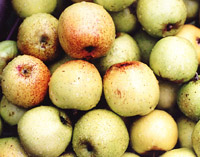 |
LUCOMBE'S
PINE A late dessert apple, raised by Lucombe's Nursery of Exeter
in Devon around 1800. Golden skinned with russet spots, it has firm and
juicy flesh and a strong flavour of pineapples. Light crops that store
until Christmas. Spur bearing and recommended for espaliers. It has also
been used for juice and cider. Pollination Group 4 |
|||
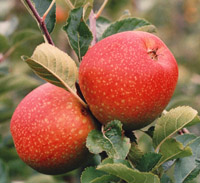 |
MABBOTT'S
PEARMAIN Syn. Canterbury. A popular dessert apple around Maidstone
in Kent, in the 19th century, originating in Langley. It was introduced
in 1883, by Lewis Killick of Langley but was already long established.
A medium sized, squarish apple, almost covered with crimson and prominently
spotted. The full flavoured fruit has juicy, sweet flesh. A heavy cropping
part tip bearer which stores until the end of the year. Pollination Group
4 |
|||
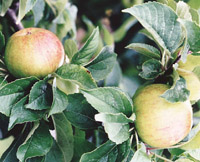 |
MACLEAN’S FAVOURITE Raised around 1820 by Dr. Allan Maclean of Sudbury, Suffolk, who then went to Colchester, Essex (- our thanks to Andrea Davies for correcting the record. She is a descendant and has researched the origin of the apple). A medium sized, late season dessert apple with yellow skin and crisp, richly flavoured flesh. Hogg says it prefers light, warm soils where it will fruit prolifically, but it is prone to canker in damp soils. Barron in 1883 recorded another early season culinary apple of the same name. Scott agreed with Hogg, describing it as a top quality apple, ripe from November and storing to January. Roundish, rich, highly flavoured and ‘of very high excellence’. Trees are vigorous and good bearers. The London Horticultural Society catalogue of 1842 also called it ‘of the highest excellence’. It has some history of being used as a cider sweet. The apple currently known as Maclean’s Favourite is more striped than ‘yellow skin’ would suggest. Pollination Group 5 | |||
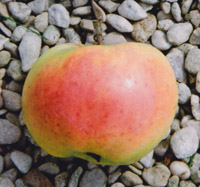 |
MADELEINE
Often confused, in the past, with Margaret and Summer Pippin, but it is
distinct. It is probably French but was known in Britain as early as 1790.
It seems to have disappeared here, in the modern age, but is still held
by the French National Collection and they kindly sent us scion-wood in
2006. Though similar to Margaret as a small, early, dessert apple, Hogg
(1884) affirms that it is distinct, despite Lindley’s assertions
that they are synonymous. Ripe in August, the apples are small, with pale
yellow skin, flushed orange in the sun, with occasional red streaks and
with many pearly specks. The flesh is juicy, sweet and with a good flavour
for an early apple, though it is a bit soft, even from the tree. Pollination
Group 4 |
|||
|
||||